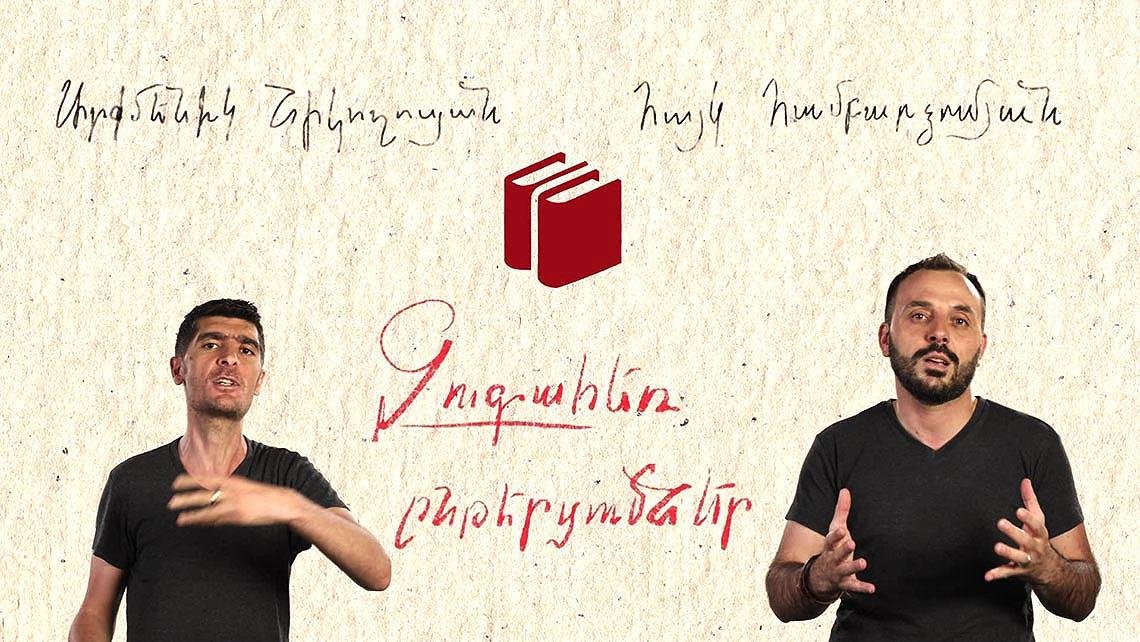
Literary critics Hayk Hambardzumyan and Arkmenik Nikoghosyan debate on the most famous, popular, and at the same time controversial works of Armenian classical and world literature. Each discussion is dedicated to one literary work, the debate of the literary critics presents the possibilities of its traditional and new perception.
 |
The literary legacy of Khrimyan HayrikKhrimyan Hayrik's activities as a clergyman and as Catholicos of All Armenians have been highly appreciated and revered by his contemporaries and future generations. One of the most important aspects of this activity is Khrimyan Hayrik's literary legacy, which is discussed in the "Parallel Readings" program by literary critics Hayk Hambardzumyan and Arkmenik Nikoghosyan. |
 |
Letter to the SaviorMovses Khorenatsi in his work "History of the Armenians" presents the correspondence between King Abgar of Edessa and Jesus Christ. This remarkable motif is also known from other Armenian and foreign sources and finds its new expression in Armenian literature of the later period. In the program "Parallel Readings", literary scholars Hayk Hambardzumyan and Arkmenik Nikoghosyan discuss the topic of the correspondence between the king and the Savior. |
 |
When Saying Armenia: The Homeland in Hamo Sahyan's PoetryHamo Sahyan's poems dedicated to Armenia are especially unique. What elements and symbols make up Sahyan's Armenia? Is he writing about historical Armenia or Soviet Armenia? How do landscapes complete the image of the homeland? Literary critics Hayk Hambardzumyan and Arkmenik Nikoghosyan discussed these issues on the "Parallel Readings" program. |
 |
I'll see Ani and then die, part 2How does the perception of Ani change over time: from a world-famous city to a sinful and cursed city? How is the city of Ani perceived in modern times: as a symbol of past glories or of statehood in general? The “Ani” originals of Armenian literature were discussed in the “Parallel Readings” program by literary critics Hayk Hambardzumyan and Arkmenik Nikoghosyan. |
 |
I'll see Ani and then die, part 1Ani, the famous capital of Bagratid Armenia, has been represented in Armenian literature in a variety of ways. The "Ani" originals of Armenian literature are discussed by literary critics Hayk Hambardzumyan and Arkmenik Nikoghosyan in the "Parallel Readings" program. |
 |
Ghazaros Aghayan, writer and educatorThis year marks the 185th anniversary of the birth of writer, educator, and publicist Ghazaros Aghayan. Literary critics Hayk Hambardzumyan and Arkmenik Nikoghosyan discuss the writer's literary and pedagogical activities in the "Parallel Readings" program. |
 |
Women in Armenian medieval talesIn Armenian medieval poetry, as well as in folk songs and folk songs, the theme of love finds its own unique expression, which, of course, is presented in praise of the beloved woman. The peculiarities of the depiction of women in Armenian medieval poetry were discussed in the program "Parallel Readings" by literary critics Hayk Hambardzumyan and Arkmenik Nikoghosyan. |
 |
Ruben Sevak: Love and TragedyRuben Sevak's love poetry enchants with its lyricism, grandeur and directness of emotions. The tragic life and works of the most original poet in Armenian literature were discussed on the program "Parallel Readings" by literary critics Hayk Hambardzumyan and Arkmenik Nikoghosyan. |
 |
Kostan Zaryan the PoetAlthough the famous Armenian writer Kostan Zaryan is best known for his novel "The Ship on the Mountain", he has also written poems and published a collection since his youth. Kostan Zaryan presents the poetry of the great and unique poet to the program "Parallel Readings" |
 |
Vahan Teryans entranceVahan Teryan revolutionized Armenian literature with his very first collection, “With the Shadows of Twilight.” Where and how did Teryan’s unique poetry come from, and what innovations did Teryan bring? Literary critics Hayk Hambardzumyan and Arkmenik Nikoghosyan talk about these issues in the “Parallel Readings” program. |
 |
Foreign Heroes of Armenian Literature: Part 2In Soviet Armenian and Modern literature, foreign heroes are more full-blooded, presented from different sides and with psychological depth, reflecting the ideology of the period and the realities of new times. In the framework of the "Parallel Readings" program, literary critics Hayk Hambardzumyan and Arkmenik Nikoghosyan discuss. |
 |
Foreign Heroes of Armenian Literature: Part 1Armenian authors have created characters of foreign heroes at different times, dedicating poems to them. In Armenian medieval and modern literature, these heroes are somewhat stereotyped, but nevertheless reveal the nuances of our attitude towards foreigners. In the framework of the “Parallel Readings” program, literary critics Hayk Hambardzumyan and Arkmenik Nikoghosyan discuss. |
